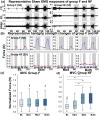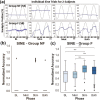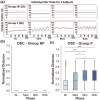Minimal handgrip force is needed for transcutaneous electrical stimulation to improve hand functions of patients with severe spinal cord injury
- PMID: 35545644
- PMCID: PMC9095635
- DOI: 10.1038/s41598-022-11306-5
Minimal handgrip force is needed for transcutaneous electrical stimulation to improve hand functions of patients with severe spinal cord injury
Abstract
Spinal cord stimulation enhanced restoration of motor function following spinal cord injury (SCI) in unblinded studies. To determine whether training combined with transcutaneous electrical spinal cord stimulation (tSCS), with or without systemic serotonergic treatment with buspirone (busp), could improve hand function in individuals with severe hand paralysis following SCI, we assessed ten subjects in a double-blind, sham-controlled, crossover study. All treatments-busp, tSCS, and the busp plus tSCS-reduced muscle tone and spasm frequency. Buspirone did not have any discernible impact on grip force or manual dexterity when administered alone or in combination with tSCS. In contrast, grip force, sinusoidal force generation and grip-release rate improved significantly after 6 weeks of tSCS in 5 out of 10 subjects who had residual grip force within the range of 0.1-1.5 N at the baseline evaluation. Improved hand function was sustained in subjects with residual grip force 2-5 months after the tSCS and buspirone treatment. We conclude that tSCS combined with training improves hand strength and manual dexterity in subjects with SCI who have residual grip strength greater than 0.1 N. Buspirone did not significantly improve the hand function nor add to the effect of stimulation.
© 2022. The Author(s).
Conflict of interest statement
D.C.L has shareholder interest in Onward and Restore Technologies. V.R.E. has shareholder interest in Onward and SpineX. PG has shareholder interest in SpineX. After ending affiliation with UCLA, L.M. gained employment at Boston Scientific Corporation and later became a stakeholder in Boston Scientific Corporation. The content of this publication is under the sole responsibility of its author/publisher and does not represent the views or opinions of Boston Scientific Corporation. All the other authors have no competing-interest (R.H., A.A.N., S.Z., E.M., T.S., D.S., T.L., T.H., M.M., M.A., M.A., Y.Z., M.R.N., M.S., and J.C.L.).
Figures







Similar articles
-
A single session of motor imagery paired with spinal stimulation improves manual dexterity and increases cortical excitability after spinal cord injury.Clin Neurophysiol. 2025 Jun;174:160-168. doi: 10.1016/j.clinph.2025.03.047. Epub 2025 Apr 20. Clin Neurophysiol. 2025. PMID: 40279945
-
Safety and Feasibility of Cervical and Thoracic Transcutaneous Spinal Cord Stimulation to Improve Hand Motor Function in Children With Chronic Spinal Cord Injury.Neuromodulation. 2024 Jun;27(4):661-671. doi: 10.1016/j.neurom.2023.04.475. Epub 2023 Jun 1. Neuromodulation. 2024. PMID: 37269282
-
Engaging cervical spinal circuitry with non-invasive spinal stimulation and buspirone to restore hand function in chronic motor complete patients.Sci Rep. 2018 Oct 19;8(1):15546. doi: 10.1038/s41598-018-33123-5. Sci Rep. 2018. PMID: 30341390 Free PMC article.
-
Transcutaneous spinal cord stimulation effects on spasticity in patients with spinal cord injury: A systematic review.J Spinal Cord Med. 2023 Jul;46(4):582-589. doi: 10.1080/10790268.2021.2000200. Epub 2021 Dec 2. J Spinal Cord Med. 2023. PMID: 34855565 Free PMC article.
-
Transcutaneous spinal cord stimulation and motor responses in individuals with spinal cord injury: A methodological review.PLoS One. 2021 Nov 18;16(11):e0260166. doi: 10.1371/journal.pone.0260166. eCollection 2021. PLoS One. 2021. PMID: 34793572 Free PMC article.
Cited by
-
Electrical Stimulation and Motor Function Rehabilitation in Spinal Cord Injury: A Systematic Review.Cureus. 2024 May 31;16(5):e61436. doi: 10.7759/cureus.61436. eCollection 2024 May. Cureus. 2024. PMID: 38947571 Free PMC article. Review.
-
Targeted transcutaneous spinal cord stimulation promotes persistent recovery of upper limb strength and tactile sensation in spinal cord injury: a pilot study.Front Neurosci. 2023 Jul 7;17:1210328. doi: 10.3389/fnins.2023.1210328. eCollection 2023. Front Neurosci. 2023. PMID: 37483349 Free PMC article.
-
Spinal cord injury: molecular mechanisms and therapeutic interventions.Signal Transduct Target Ther. 2023 Jun 26;8(1):245. doi: 10.1038/s41392-023-01477-6. Signal Transduct Target Ther. 2023. PMID: 37357239 Free PMC article. Review.
-
Spinal Cord Transcutaneous Stimulation in Cervical Spinal Cord Injury: A Review Examining Upper Extremity Neuromotor Control, Recovery Mechanisms, and Future Directions.J Neurotrauma. 2024 Sep;41(17-18):2056-2074. doi: 10.1089/neu.2023.0438. Epub 2024 Jul 12. J Neurotrauma. 2024. PMID: 38874496 Review.
-
Spinal cord stimulation for spinal cord injury - Where do we stand? A narrative review.J Clin Orthop Trauma. 2023 Jul 29;43:102210. doi: 10.1016/j.jcot.2023.102210. eCollection 2023 Aug. J Clin Orthop Trauma. 2023. PMID: 37663171 Free PMC article.
References
-
- Freehafer AA. Care of the hand in cervical spinal cord injuries. Paraplegia. 1969;7:118–130. - PubMed

